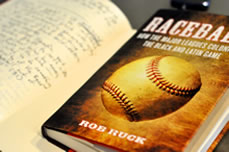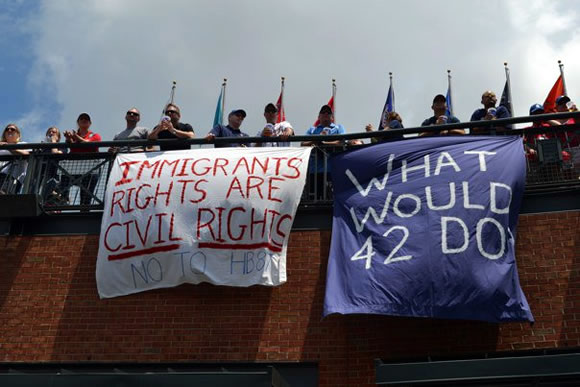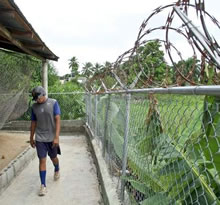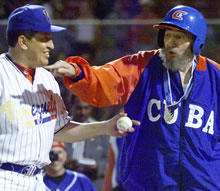Posted July 25, 2011
 Raceball: How the Major Leagues Colonized the Black and Latin Game
Raceball: How the Major Leagues Colonized the Black and Latin Game
Rob Ruck
Beacon Press, 273 pp.
Perhaps it’s fitting that I first heard about Raceball just before unfurling a banner at Atlanta Braves’ Turner Field that read “Immigrants Rights Are Civil Rights.” It was Civil Rights Day at the ballpark and several Negro Leagues veterans were taking the field to receive honors in front of thousands of fans. It was also the day after Georgia Governor Nathan Deal signed HB 87, a bill targeting immigrants in a similar fashion to Arizona’s notorious SB 1070. Paul D’Amato, one of my co-conspirators that day and no stranger to taking a stand at a ballpark in support of immigrants’ rights, gave a quick but glowing review of the book as we shifted from beer-drinking fan mode to banner-dropping activist mode and began fastening the banners to the railing in the outfield. In addition to the one mentioned above, another banner read “What Would 42 Do?” in reference to the only number retired across the MLB, that of baseball and Civil Rights legend Jackie Robinson.
“[HB 87] is going to get some innocent people harassed here,” stated Curacao-born starting pitcher Jair Jurrjens in an article published days before the game. For this very reason, the MLB Players’ Association issued a statement opposing its inspiration, SB 1070, in protection of its many Latino members who play at Chase Field and in the many Cactus League minor league teams of Arizona. Maybe Jurrjens–who took an Atlanta no-hitter into the 6th inning that day, eventually earning the win over the Philadelphia Phillies–saw our banner or heard about it from Venezuelan teammate Martin Prado, playing in the nearby outfield. Unfortunately, it didn’t take long for Turner Field security to remove the banners, telling us that the baseball field, even on Civil Rights Day, was no place for politics.

Thanks to writers like Rob Ruck, we are reminded of the many ways that the politics of race and empire have shaped the game of baseball since its very beginning on the battlefields of the US Civil War. Ruck’s Raceball provides an accessible and fascinating narrative of baseball as a transnational sport–propelled by US hegemony as well as anti-colonial aspirations–in a manner that would please even C. L. R. James. The strongest chapters in Ruck’s book chart the development of the Caribbean baseball traditions in Cuba, Dominican Republic, and Puerto Rico and their interactions with the Negro Leagues of the US. It was in these countries and their international (racially integrated) competitions, Ruck asserts, that the popular heart and soul of baseball could be found. White North Americans may have “had [baseball] fever and had it bad,” but the passion and competitiveness of the game played between Black and Latin players from 1900 to 1947 was unmatched, until it was subordinated (colonized) by Major League Baseball.
At a time when baseball fans in the US ask with ever-greater nervousness whether their game is still worthy of the title “national pastime”–according to a 2011 Rasmussen poll, only 29% of us are delusional enough to answer in the affirmative—Raceball offers an alternative historical framing, freed of the white blind spots that allow so many to consider the sport a uniquely “[North] American” tradition. If anything, baseball was a transnational pastime until two main developments uprooted the grassroots popularity of the game: the elimination of leagues that challenged the imperial reach of the MLB, such as Jorge Pasquel’s insurgent Mexican League, and the destruction of the Negro Leagues upon integration of the MLB. Though the six decades following these events have given MLB players and fans no shortage of exciting moments, their effects resound from the empty ball fields of the inner cities to the decline of winter league play in Venezuela, Dominican Republic, and, most of all, Puerto Rico.
MLB Commissioner Bud Selig has been forced to acknowledge dimensions of the problem, albeit in a constrained manner. African Americans now account for approximately 9% of players and only 6% of African Americans polled consider themselves primarily baseball fans–hence, the yearly “Civil Rights Game” that promotes the integration of baseball as an event that laid the groundwork for the Civil Rights movement of the 1950s and 1960s. Raceball undoes this myth of corporate multiculturalism (without diminishing the accomplishments and struggles of African American players) by documenting how integration also brought one of the largest Black-owned enterprises to its demise.
Ruck charts the development of the Negro Leagues from the 1890s to 1940s as African Americans migrated to northern cities in search of economic opportunity and relative release from the oppressive conditions of the Jim Crow south. He spotlights his native Pittsburgh (see also Ruck’s 1993 book Sandlot Seasons: Sport in Black Pittsburgh) as well as “black baseball’s capitol,” the South Side of Chicago, and its “mayor,” the pitching virtuoso-turned-manager Rube Foster (29). His descriptions of the feats of Cool Papa Bell, Satchel Paige, Josh Gibson, and myriad other Negro Leaguers are a pleasure to read for any fan. The stark contrast of these stars’ experiences playing in the Caribbean and Central America with playing in the United States reveals as much about the racial attitudes of the period as it does about the relative competitiveness of the various regions. Baseball commissioner Kennesaw Mountain Landis’ response, quite tellingly, was to forbid white professional ballplayers from participating in these exchanges out of fear that they would be proven outmatched (though this rule was often broken for various reasons).
The Negro Leagues were to become important expressions of Black self-determination in a ruthlessly oppressive white supremacist nation. With the demise of the Negro Leagues, thousands of talented and creative Black managers, coaches, owners, and players were left behind. One can see parallels in how integration of public schooling also left behind thousands of Black teachers and principals. Though organized baseball would no longer function “to reinforce white assumptions about black inferiority” (25) to white fans, integration (in baseball as in other endeavors) was insincere, halting, and often had the effect of weakening those spaces where racially oppressed minorities had summoned greater degrees of power and agency. Ruck examines what he calls “integration’s curse” not to glorify the days of segregation or to characterize the Negro Leagues as perfect and uncomplicated institutions, but to explain how the MLB colonized the African American game in its quest to eliminate competition and to preserve and extend the power of white owners in the face of popular challenges to legal apartheid. It’s a critically important analysis to consider for anyone seeking ways to reverse the downward trend of African American participation at every level of the game.
 This story is interwoven with that of the Caribbean and Central/South American baseball traditions, whose independence is increasingly subordinated to neoliberal baseball “academies” that (cheaply) develop talents for the profits of MLB owners at the expense of a vibrant and popular amateur game. Ruck describes this as “a serious and profound shift in power” (219)–but it’s surprising (to this fanático del béisbol norteamericano, anyways) to learn how fiercely independent the game had been, even amid persistent US military interventions. The history is deep and complicated, but Raceball provides a detailed exposition that discusses not just the “political economy” of the game, but the great talents and personalities that embodied el espíritu de béisbol and, at times, an anti-colonial pride.
This story is interwoven with that of the Caribbean and Central/South American baseball traditions, whose independence is increasingly subordinated to neoliberal baseball “academies” that (cheaply) develop talents for the profits of MLB owners at the expense of a vibrant and popular amateur game. Ruck describes this as “a serious and profound shift in power” (219)–but it’s surprising (to this fanático del béisbol norteamericano, anyways) to learn how fiercely independent the game had been, even amid persistent US military interventions. The history is deep and complicated, but Raceball provides a detailed exposition that discusses not just the “political economy” of the game, but the great talents and personalities that embodied el espíritu de béisbol and, at times, an anti-colonial pride.
For Cubans at the turn of the 20th century, baseball presented an emancipatory alternative to Spanish colonial influences. Unlike bullfighting, games were open to female spectators and Afro-Cuban participants. It was for the most part a multi-racial and working class affair. Games were used as fundraising opportunities for the struggle against Spanish domination–and shifted eventually to sites of struggle against the US occupiers. Ruck details how “victories over the North Americans, and the feats of Cubans in them, became part of the island’s political mythology” (13). The stories of Afro-Cuban legends like Jose de la Caridad Mendez (“el Diamante Negro“), who no-hit the Cincinnati Reds for 25 consecutive innings in 1908 and later went on to lead the Kansas City Monarchs to their first Negro National League World Series in 1924, are worth the price of the book alone.
Almost as soon as baseball took root, it was Cuba–not the United States–that most effectively spread the gospel of baseball in the region. The first nation to match Cuban and North American intoxication with the sport was the Dominican Republic. After Dominicans learned the sport largely from Cuban expats, “it was during the epoch of the North American occupation that baseball was really ignited,” recalled Manuel Báez Vargas. “In the east, the guerillas were fighting the Marines, but in the capital, we played ball with them” (50). With the rise of US-backed anti-communist dictator Rafael Trujillo, baseball became subject to a patriotic modernization that, ironically, “posed the first significant foreign challenge to professional baseball in the United States” (49). Trujillo himself was not interested in the sport, but was very interested “in keeping people in such a condition that they didn’t bother with politics,” according to Báez Vargas. To this end, he enticed players from other countries with grand contracts (including star Negro Leaguers like Satchel Paige, Cool Papa Bell, Josh Gibson, Sammy Bankhead, and Leroy Matlock) to play for his teams, even at risk of being banned from play in the US (53). Of course, Trujillo’s Dominican Republic was no racial utopia, not even compared to Jim Crow–in 1937, after the star Negro Leaguers left the country, Trujillo rounded up and killed thousands of Black Haitians in an effort to “whiten” his nation. (Ruck has also written extensively on baseball in the Dominican Republic in his 1999 book The Tropic of Baseball: Baseball in the Dominican Republic.)
Juan Bosch, the first democratically elected Dominican president following the assassination of Trujillo in 1963, recalled a culture of baseball more complex than the one Trujillo had organized. Even as his countrymen played with the US Marines sent to prevent his return to power after a US-backed coup, he insisted “[these] games were not a form of collaboration with the North Americans,” but a way to assert independence against the North Americans (51). Perhaps the distinction between sports as “distraction” and sports as expressions of independence, self-determination, and fair play is a subtle one, dependent on the balance of forces in a specific context. Raceball illustrates baseballs dance between these positions over its long history. It’s difficult, as an enthusiastic (and long-winded) reviewer, to refrain from relating more of these stories–particularly that of the Mexican “baseball war” that presented the most significant challenge to MLB hegemony in the history of the sport–but some things should remain unspoiled, I suppose.
Ruck writes with an accessible style, but footnotes with academic rigor, making Raceball a great read for fans, activists, and scholars alike. Most importantly, for this reviewer, he writes with a genuine love for the game, which is not always present among left critics of professional sports, whose prejudice may blind them to nuance and complexity. As for weaknesses, there are few that are glaring. I can’t help but wonder how another section (or another book, perhaps?) looking at the development of baseball in East Asia would fit with Ruck’s discussion of the Black/Latin game. What of the dynamics of military occupation, resistance, and transpacific barnstorming in Japan and South Korea? While the scores may have been a bit lopsided, what were the interactions of Black and Japanese players in the 1920s?
 Finally, many questions remain about the character of left-nationalist opposition to the extension of the MLB’s reach in Cuba and Venezuela. In the former case, there is a rich post-revolution history of the sport–sadly, Ruck’s history of Cuban baseball ends at 1959, aside from speculation that liberalized relations with Cuba may extend the academy system to its shores. As for Venezuela, how does the anti-neoliberal Bolivarian revolution affect regulation of baseball? In any of these cases, how should nations resist the colonization of the MLB without resorting to protectionist measures that limit the transnational possibilities of a game that, at its best, knows no borders? Perhaps the answers are within closer reach than I imagine. That I haven’t asked the questions until reading Raceball, though, should only be read as a high compliment to what Rob Ruck has accomplished.
Finally, many questions remain about the character of left-nationalist opposition to the extension of the MLB’s reach in Cuba and Venezuela. In the former case, there is a rich post-revolution history of the sport–sadly, Ruck’s history of Cuban baseball ends at 1959, aside from speculation that liberalized relations with Cuba may extend the academy system to its shores. As for Venezuela, how does the anti-neoliberal Bolivarian revolution affect regulation of baseball? In any of these cases, how should nations resist the colonization of the MLB without resorting to protectionist measures that limit the transnational possibilities of a game that, at its best, knows no borders? Perhaps the answers are within closer reach than I imagine. That I haven’t asked the questions until reading Raceball, though, should only be read as a high compliment to what Rob Ruck has accomplished.

Comments
One response to “Baseball without Borders: Review of “Raceball””
The author discusses his research in this cool video here: http://youtu.be/ARldSPbnWQs